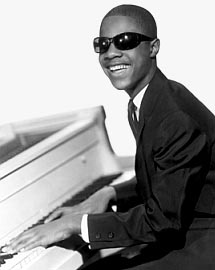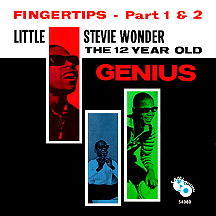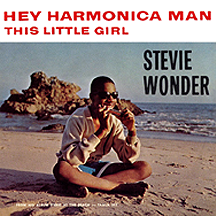STEVIE WONDER
As a child, Stevland Hardaway Judkins overflowed with a joyous love of life, and it rubbed off on everyone he knew. Little Stevie had plenty of reasons not to be this way; he lost his eyesight as an infant, and at the age of four his parents split, leaving the responsibility of raising six children to his mother. Lula Mae Hardaway deserves most of the credit for how her children turned out. Rather than draw attention to her son's blindness, she and his five siblings carried on as though nothing was out of the ordinary, choosing instead to focus on the positive aspects of life. It worked. You'd have been hard pressed to find a happier child than Stevie.
Born in Saginaw, Michigan in 1950, Stevie's family moved to Detroit in 1954, and at about that time his legal surname was changed to Morris, after his uncle Walter. Singing in church choir as a child, his passion for music extended to the study of piano, organ, harmonica, drums and bongos. Gerald White, a friend of the family, was impressed by Stevie's skills and uniqueness. It just so happened his brother, Ronnie White, was a member of hot Tamla Records group The Miracles. When Ronnie took Stevie to Motown, boss Berry Gordy wasn't immediately impressed with the kid's singing, but liked the harmonica playing and bongo bangin' and thought he might be marketable. A few felt he could become the next Ray Charles. He was signed to the label as an artist at the age of eleven. There are a couple of contradicting accounts of how the youngster got his professional name. One is based on Gordy's comment, "Boy! That kid's a wonder!" when seeing him for the first time, though he doesn't remember saying it. Clarence Paul, who would become Stevie's producer, called him the "8th wonder of the world." At any rate, he quickly became known around the Hitsville offices as Little Stevie Wonder.
Stevie was quite a prankster, which kept people on their toes around the Motown Records studio. He would pretend he could see what a person was wearing (with the help of someone who would tip him off). Sometimes he would appear to be reading a book (a passage he obviously knew by heart). He made silly attempts at imitating Gordy's voice in a gruff manner and would have gotten in trouble for it, but the company president thought it was as funny as everyone else did. The entire staff enjoyed the positive energy he brought and looked forward to seeing what he would try to pull next.
Gordy took a different approach to his promotion of the young artist than he did with most Motown acts. After Little Stevie's debut single on Tamla, "I Call it Pretty Music, But the Old People Call it the Blues," failed to generate interest, he released an all-instrumental album, The Jazz Soul of Little Stevie, in an effort to show off different facets of the young musician's talent. The Henry Cosby-Clarence Paul composition, harmonica-and-bongo big band blast "Fingertips," led off side one. There were two more singles and another album, Tribute to Uncle Ray, which drew an obvious comparison in an homage to Ray Charles.
At one of the many Motortown Revue shows, which featured all of the label's acts at one time or another, Stevie delivered the performance that ultimately made him a star. An energetic "Fingertips" jam session ran a total of seven minutes when Stevie was called back onstage for an encore. An album taken from several live shows, 12 Year Old Genius, came out in July 1963, with the song split into two parts for single release. The B-side, "Fingertips - Part 2," with its final two minutes and encore, shot to the top, one of only a few live performances in music history to hit number one ("Peppermint Twist" by Joey Dee and the Starliters had pulled off the trick the year before). By the end of August, both the single and album were simultaneously number one on their respective charts. Little Stevie Wonder was hot.
Then he cooled off. Follow-up 45 "Workout Stevie, Workout" made the top 40, but the next single, the ballad "Castles in the Sand," struggled. The "fun" records seemed to work best; "Hey Harmonica Man" put him back in the top 40 in the summer of '64. Appearances in the Frankie Avalon and Annette Funicello films Muscle Beach Party (jammin' at Cappy's beachfront nightclub with Dick Dale and his Del-Tones!) and Bikini Beach added to the fun and provided fans with excellent color footage of the Boy Wonder in action. But by the time a remake of Tommy Tucker's "High Heel Sneakers" came out in '65, sans the "Little" in Stevie's name, his future with Motown was in question. Gordy was considering dropping him from the roster, figuring his success had been a one-shot novelty kind of thing, and as his voice was beginning to change, he figured time had run out. Luckily for Stevie, Motown staffer Sylvia Moy saw potential that Gordy hadn't. She convinced him to let her work with the young artist to try to find a new approach and come up with a hit record. Moy, Henry Cosby and Stevie cowrote "Uptight (Everything's Alright)," based on the rhythmic hook of "(I Can't Get No) Satisfaction" by The Rolling Stones. It was a smash, a top ten pop and number one R&B hit in early 1966.
"Nothing's Too Good For My Baby" utilized the "Uptight" template and Stevie's recently-matured voice fit in well with "The Motown Sound." Then he scored back-to-back top tens with Bob Dylan's "Blowin' in the Wind" and "A Place in the Sun," written by Ron Miller and Bryan Wells, the first signs of a socially conscious direction for the singer. Another Miller-Wells song, "Travlin' Man," also contained lyrics more thought-provoking than the early Wonder works. Stevie's development as a songwriter grew with the help of Moy and Cosby; even his mother Lula Mae contributed to the mock-autobiographical "I Was Made to Love Her," a huge hit in the summer of '67, his biggest since "Fingertips." Next up was "I'm Wondering," which suggested he couldn't resist a play on words with his now-famous stage name. Then came another top ten, "Shoo-Be-Doo-Be-Doo-Da-Day," and the funkier-than-usual "You Met Your Match" in 1968.
His all-instrumental album in '62 had been so much fun that Stevie decided to do it again, while staging another of the pranks his close friends had come to expect...only this time the joke was on the listeners. Using the backwards-spelled pseudonym Eivets Rednow, he put together an entire album of instrumentals, mostly harmonica solos, and released Burt Bacharach and Hal David's "Alfie" as a single; both were on the Gordy label instead of Tamla. It didn't take long for everyone to figure out what was actually going on, that Rednow was really Wonder and Eivets was pulling all of our legs.

Berry Gordy had a few tricks up his sleeve, too. His plan had always been to establish his artists as both soul singers and pop singers in order to reach the largest audience possible. He established Stein and Van Stock Publishing (names that had no basis in reality, he just liked the way they sounded) for songs his writers came up with that had a pop standard feel, while continuing to put the majority of works under his first publishing company, Jobete. Ron Miller was his main writer for Stein and Van Stock; with Orlando Murden he penned "For Once in My Life," first recorded by Tony Bennett in 1967. Tony had a minor hit with the song, then with Henry Cosby producing, Stevie made an uptempo version that hit big in late 1968. Stevie's versatility was becoming more apparent with each release.
He had a big year in 1969, starting with the two-sided hit "I Don't Know Why" and its more successful flip, another Cosby-Wonder-Moy song, "My Cherie Amour." Miller and Wells contributed "Yester-Me, Yester-You, Yesterday" to close out the decade. If his career had stopped right there, Wonder would have had a solid body of work to rest his laurels on. It's hard to imagine, had Gordy cut him loose years earlier, what it would be like with only the "Little" version of Stevie in our memory banks. But fate decreed that he stick around just a little longer - say, another 40 years and counting.
In September 1970 he married Syreeta Wright, a former Motown secretary turned songwriter and accomplished singer. Then in '71, at age 21, his contract expired. With the help of a lawyer who turned out to be a tough negotiator, Gordy agreed to a deal that provided higher royalties and gave Stevie complete creative control. This new contract was a success for everyone involved. Maybe we should start calling him "Big" Stevie Wonder; several top-selling, critically acclaimed albums followed, nine more number one hits, 22 Grammy Awards and an Oscar all resulted from an extended, creative two-decade period in the life of Motown's all-time greatest star.
NOTABLE SINGLES:
- I Call it Pretty Music, But the Old People Call it the Blues - 1962
as Little Stevie Wonder - Contract on Love - 1963
as Little Stevie Wonder - Fingertips - Part 2 - 1963
as Little Stevie Wonder - Workout Stevie, Workout - 1963
as Little Stevie Wonder - Castles in the Sand - 1964
as Little Stevie Wonder - Hey Harmonica Man - 1964
- High Heel Sneakers - 1965
- Uptight (Everything's Alright) - 1966
- Nothing's Too Good for My Baby /
With a Child's Heart - 1966 - Blowin' in the Wind - 1966
- A Place in the Sun - 1966
- Travlin' Man /
Hey Love - 1967 - I Was Made to Love Her - 1967
- I'm Wondering - 1967
- Shoo-Be-Doo-Be-Doo-Da-Day - 1968
- You Met Your Match - 1968
- Alfie - 1968
as Eivets Rednow - For Once in My Life - 1968
- I Don't Know Why /
My Cherie Amour - 1969 - Yester-Me, Yester-You, Yesterday - 1969
- Never Had a Dream Come True - 1970
- Signed, Sealed, Delivered I'm Yours - 1970
- Heaven Help Us All - 1970
- We Can Work it Out /
Never Dreamed You'd Leave in Summer - 1971 - If You Really Love Me - 1971
- Superwoman (Where Were You When I Needed You) - 1972





